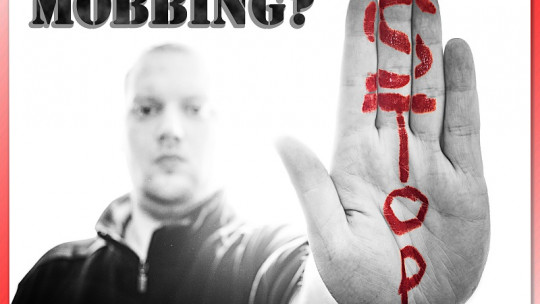Workplace harassment, also known as mobbing , is a phenomenon that can occur at work. It occurs when a stalker (or stalkers) repeatedly exerts violence (usually psychological) on one or more victims.
The consequences for the person who receives the harassment are devastating, since mobbing not only causes intense discomfort (sadness, anxiety, insomnia, etc.), but it also tends to destroy its reputation.
The profile of the workplace harasser according to Tim Field
Much has been said about what leads a person to become a stalker. In the following lines you can find the personality profile of the workplace harasser taking into account the opinion of different researchers.
To begin with, we must bear in mind that one of the first researchers to be interested in this phenomenon was Tim Field, a British researcher who in 1996 described the workplace harasser as:
1. Liar
The workplace harasser is more likely to tell lies and modify the truth to accuse the victim of all evils He is a person who is very comfortable in lying, and is characterized by a personality in which he projects a false image of himself.
2. Charming
Being a liar, he easily deceives those around him. That’s why he can seem charming at first, because hide your true personality
3. False appearance of security
Workplace bullies may appear confident; however, they hide low self-esteem That is why, in part, they carry out mobbing, to compensate for deficiencies in this regard.
4. Controlling and vengeful
Workplace bullies are usually controlling people and are also vindictive. They tend to make life miserable for anyone who crosses their path.
5. Critical
He tends to be critical of others, and attack their weak points. These criticisms are never constructive but harmful and aimed at causing discomfort.
6. Irritable
Although he appears to be a kind person, it is all a facade. In reality, he is easily irritable, hiding great anger inside.
7. Incapable of self-criticism
Although bullies tend to be people who are critical of others (always in a destructive way), they are not people who engage in self-criticism. On the contrary, they project their failures onto others. and use them as scapegoats.
8. Violent
These people are usually violent. In large part because They feel frustrated and hide a lot of anger inside
More personality traits
Another of the first researchers to study this phenomenon and to draw a profile of the workplace harasser was Hirigoyen in 2001. According to her, the workplace harasser is:
1. Perverse
The author calls it a perverse being, with narcissistic traits He seeks to appropriate the image of the victim and reflect his own in it.
2. Feel pleasure in seeing another suffer
The bully feels great pleasure in seeing the victim humiliated and enjoys the suffering of the other.
3. He has no regrets
He is cruel and does not care about the victim’s pain. He doesn’t feel guilt because he enjoys acting like that.
4. Low self-esteem
Has a huge inferiority complex which is a consequence of their low self-esteem. He tries to increase his own value through attacks on the victim.
5. Lack of empathy
Empathy is the ability to put yourself in the shoes of others. The workplace harasser tends to don’t put yourself in other people’s shoes
6. Deny reality
Hirigoyen affirms that the harasser uses defense mechanisms such as denial of reality
7. Project your mistakes onto the victim
Another defense mechanism that the bully uses is projection, as he projects his mistakes onto the victim.
8. Seductive
Workplace harassers often show a personality with narcissistic roots, characterized by superficial charm
The pathological side of the stalker
According to Iñaki Piñuel and Zabala, the workplace harasser presents a series of characteristics. They are the following.
1. Repeated harassment
According to this researcher, the workplace harasser is a “serial killer”, since workplace harassment behaviors They are not isolated, but they are repeated In addition, he usually harasses different individuals over the years,
2. Inferiority complex
The bully’s inferiority complex makes who tries to increase his self-esteem at the expense of others that is, trying to feel superior to them.
3. Pathological personality
It is relatively common for the stalker to present some pathology, for example, narcissistic disorder, conduct disorder, psychopathy or paranoid disorder.
Compensating for shortcomings
Psychiatrist José Luis González de Rivera describes the personality of the stalker as follows:
1. Narcissistic traits
Workplace bullies have narcissistic traits. That is, they feel an excessive sense of grandiosity, they believe they are special and they try to have their status recognized.
You can delve into the characteristics of narcissistic people with this article: “Narcissistic Personality Disorder: what are narcissistic people like?”
2. Paranoid traits
The author also thinks that workplace harassers have paranoid traits. That is, they are people who They feel a great distrust of others and an intense unfounded anticipation that other people want to cause them harm, they show a certain egocentrism and are contemplative, cold and demanding.
3. Envy
Bullies are envious people and They have no problem taking from others what they consider valuable
4. Need for control
They have a great need for control, they do not tolerate frustration and fear uncertainty
5. Mediocrity
Consider these people mediocre, in the sense that they appear empty and evil. They have a great desire for notoriety and to influence others.
And how does mobbing affect victims?
Mobbing, like any other form of harassment, causes serious problems for the victim both in their morale and in their performance at work. Workplace harassment causes:
- Loss of confidence and low self-esteem (both in the person and with respect to their work).
- Personality and behavioral changes.
- Sleeping difficulties and nightmares.
- Anxiety disorders.
- Feelings of failure and guilt.
- Extreme concern and hypervigilance.
- Depression and sadness.
- Irritability, fatigue and difficulty concentrating.
- Great demotivation for work.
- Emotional mutism and feeling of detachment from others.
- Field, T. (1996): Bully in sight, Wessex Press, Wantage.
- Hirigoyen, M. (2001). Moral harassment at work: distinguishing what is true from what is false. Pujol i Valls, Núria.
- Piñuel, I. (2001): Mobbing: how to survive psychological harassment at work. Ed. Sal Terrae. Santander.









